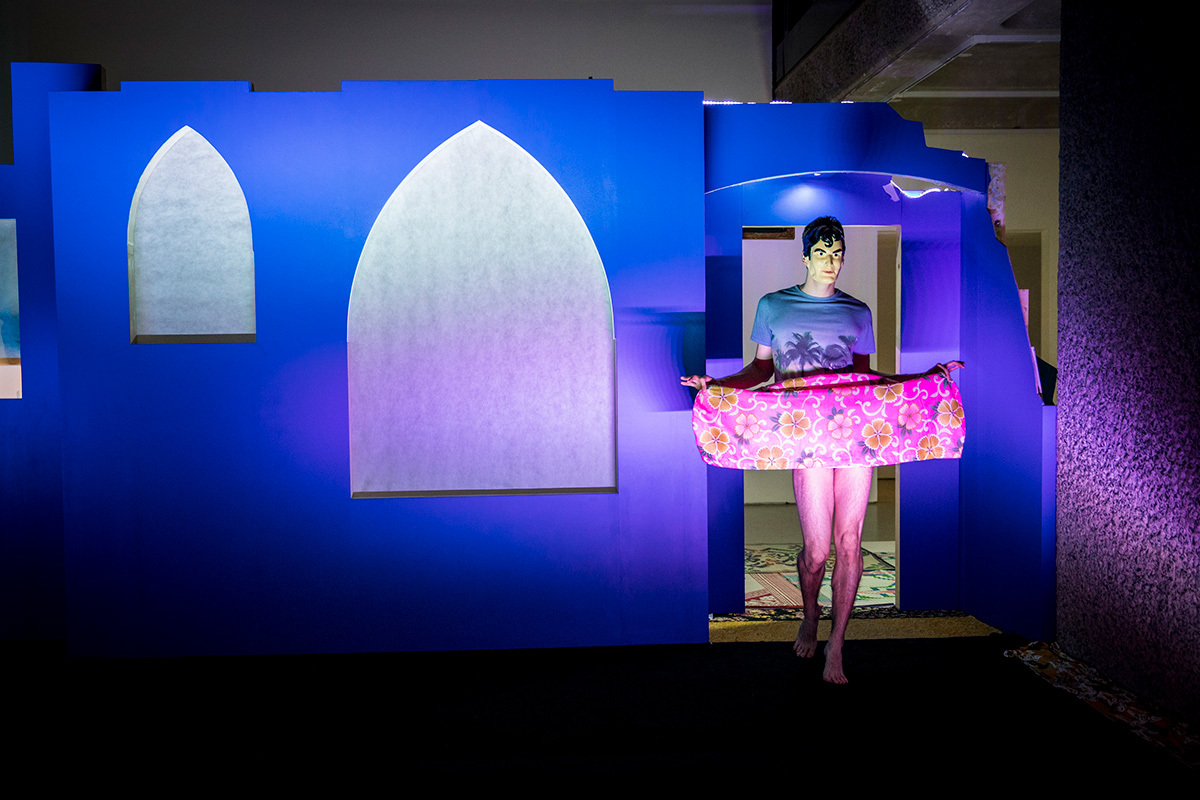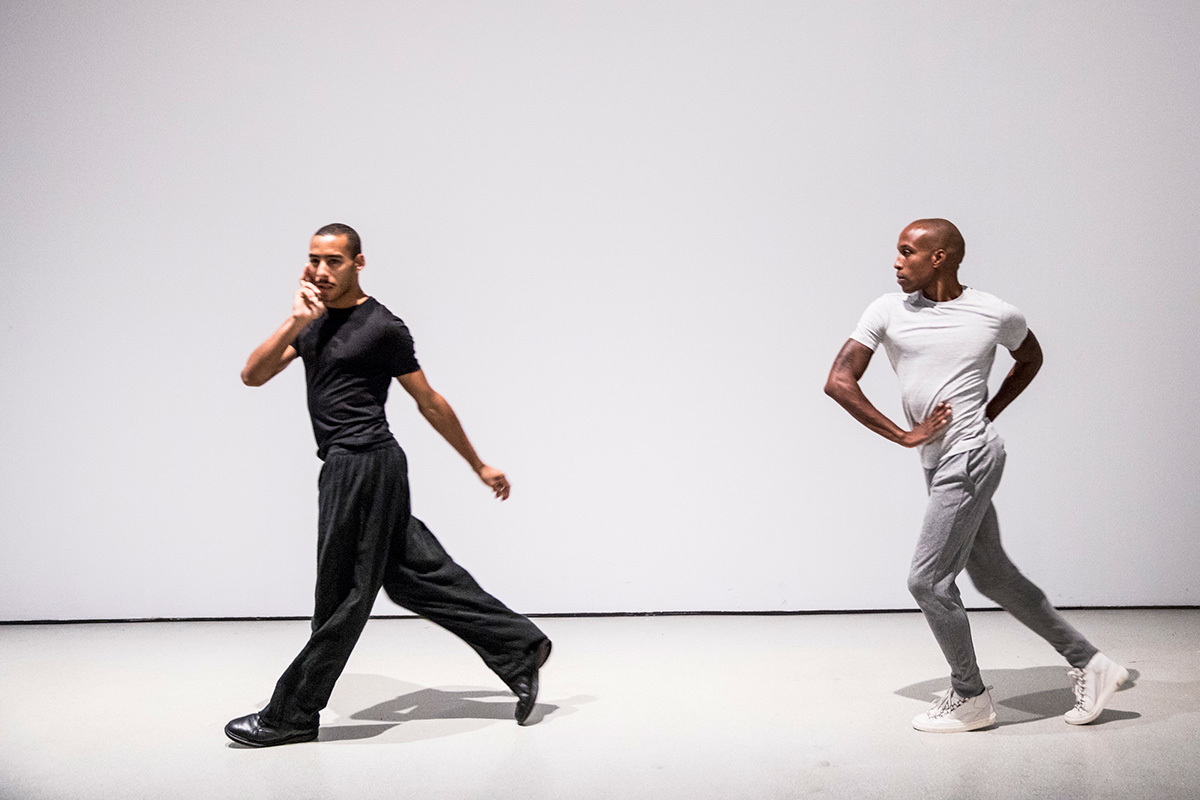Why isn’t runway movement considered dance? Right now at the Barbican, an extraordinary live exhibition is asking this very question. It is the work of Trajal Harrell, a thought-provoking American dancer and choreographer who has been deeply influenced by the runway, whether that’s the catwalk or the voguing communities of his youth.
The show is a total must-see, then must-see-again. Fresh from a two-year residency at MOMA, Hoochie Koochie is an ambitious retrospective that stages over 14 of Trajal’s dances from the last 20 years; the selection of works performed at the Barbican include studied displays of poise to visceral bouts of voguing to more performative, characterful works influenced by the catwalk, Classical Greek movement and the Japanese dance style of Butoh.

Four days a week, Trajal and his dancers perform his works in the gallery spaces, often simultaneously in different spots, the audience free to move around at will. His work breaks out of the confines of theatre: the dancers move among the audience, and use every inch of the gallery space. The movement is unlike any other in contemporary dance, and it is addictive.
In an age of fashion show experimentation — from the catwalk expressionism of London designers such as Charles Jeffrey Loverboy and Art School, to the recent movement-as-communication at Comme des Garçons — Trajal’s work is more vital than ever. Anyone with any interest in fashion as a form of performance needs to see this show. Here are ten reasons why.
1. Trajal Harrell loves fashion
“I take fashion very, very seriously,” Trajal tells us. “I don’t mean that I take clothing seriously; what I take seriously is how clothing can become material culture, what it can say about society, and how we use it in terms of what we want to project of ourselves. And of course there’s the whole culture of voguing, and how it has appropriated so much from fashion.” His love of fashion comes from a country childhood in Douglas, Georgia. “One of my earliest memories is being with my mother shopping,” he says. “Being a rural community there was no art galleries, so looking at clothes was an aesthetic experience. I think she passed that on to me in a really strong sense.”
2. He believed in runway as dance when others didn’t
“When I first experimented with runway movement as dance in 1998, it was like it was heresy,” he says. “In the New York downtown dance scene at that time, there was a real reaction against bourgeois values, and fashion was equated with luxury. I got so much negative feedback, because people were so anti-fashion. I didn’t even question what I was doing, to me it was dancing. But it’s something I’ve had to prove over the years.”

3. He has the theory to back it up
“Post-modernist choreographers like Trisha Brown set up pedestrian movement as dance,” he says. “They said any movement can be dance. So this is dance.”
4. Young Trajal would to do anything to see fashion shows
“That was my thing, sneaking into shows in New York,” he says, “getting friends to get me into shows, getting invitations. There’s something about this incredible amount of energy and theatricality going to shows. I found it so much more theatrical than what was going on at the theatre.”
5. Seeing Gisele on the catwalk was a eureka! moment
“I will never forget the first show I saw with Gisele coming down the catwalk. It was Calvin Klein, spring/summer 2001. There was this vision. It was like, ‘Is she real? Is she playing someone? Is she giving a kind of realness? Model realness? She’s just moving, but look how she’s moving’. There was this attitude. The difference between her and everyone else made it completely aesthetically riveting for me. It was my eureka moment.”
6. Voguing helped him find his own dance language
“Vogue balls were another world. I’d never seen anything like that before,” he says. “It is a tradition that also appropriated runway movements, and that guided me in a way. I was trying to break out of conceptualism, and out of conceptual dance. Voguing will always be the lens through which I see a lot of things. So much of my artistic career is based on that.” But his dancing is so much more than just voguing. “I’m respectful, but I don’t try to represent it. I was not trying to open the doors to voguing in dance history,” he insists. “Voguing doesn’t need me to open the doors. It can do that on its own if it wants. Voguing doesn’t need to be in high art institutions, it’s not its thing. I don’t know that many other forms that are able to really resist the dominant culture value system.”
7. Comme des Garçons is a major influence
“I got very into the idea of Comme des Garçons,” he says. “It offered a foil to the problemisation of beauty, and ideas of beauty. In a way, Rei Kawakubo was using ideas of ugliness, or rethinking the ideals of female beauty from the traditional ways that we see on the runway.”
8. He’s obsessed with the history of runway walking
“This history of movement is very interesting. If you look at different eras of fashion shows, you’ll see there are different ways of walking that come in. What interests me is that, a) there’s a pedagogy, and b) this pedagogy is not documented. And on top of that, the pedagogy is often done by men, so you had men teaching women how to be ‘women’. It has very complicated levels of representation and understanding, and I’m dying for someone to really study this form, really look at it and talk about it.”

9. Trajal has encouraged others to see runway as dance
“When we did auditions for this show, so many people who came could do runway. They knew all the work, and so many of them understood what I was doing. It’s very new for me, to understand that there are a lot of talented people who can do runway, and dancers who understand that this is dance.”
10. He is still only realising the work that he has done
“We keep trying to explore and expand on runway movement as dance language, and I think In The Mood For Frankie [first performed last year at MoMA in New York] was the first time I was full on like, ‘This is dance’. That’s my major contribution to the history of dance. That we can do this and say, This is dance, this is art.”

Credits
Text Charlie Porter
Photography © Tristan Fewings Getty Images
